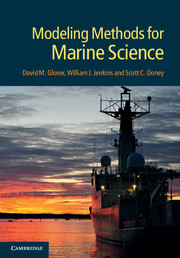Book contents
- Frontmatter
- Contents
- Preface
- 1 Resources, MATLAB primer, and introduction to linear algebra
- 2 Measurement theory, probability distributions, error propagation and analysis
- 3 Least squares and regression techniques, goodness of fit and tests, and nonlinear least squares techniques
- 4 Principal component and factor analysis
- 5 Sequence analysis I: uniform series, cross- and autocorrelation, and Fourier transforms
- 6 Sequence analysis II: optimal filtering and spectral analysis
- 7 Gridding, objective mapping, and kriging
- 8 Integration of ODEs and 0D (box) models
- 9 A model building tutorial
- 10 Model analysis and optimization
- 11 Advection–diffusion equations and turbulence
- 12 Finite difference techniques
- 13 Open ocean 1D advection–diffusion models
- 14 One-dimensional models in sedimentary systems
- 15 Upper ocean 1D seasonal models
- 16 Two-dimensional gyre models
- 17 Three-dimensional general circulation models (GCMs)
- 18 Inverse methods and assimilation techniques
- 19 Scientific visualization
- Appendix A Hints and tricks
- References
- Index
1 - Resources, MATLAB primer, and introduction to linear algebra
Published online by Cambridge University Press: 05 June 2012
- Frontmatter
- Contents
- Preface
- 1 Resources, MATLAB primer, and introduction to linear algebra
- 2 Measurement theory, probability distributions, error propagation and analysis
- 3 Least squares and regression techniques, goodness of fit and tests, and nonlinear least squares techniques
- 4 Principal component and factor analysis
- 5 Sequence analysis I: uniform series, cross- and autocorrelation, and Fourier transforms
- 6 Sequence analysis II: optimal filtering and spectral analysis
- 7 Gridding, objective mapping, and kriging
- 8 Integration of ODEs and 0D (box) models
- 9 A model building tutorial
- 10 Model analysis and optimization
- 11 Advection–diffusion equations and turbulence
- 12 Finite difference techniques
- 13 Open ocean 1D advection–diffusion models
- 14 One-dimensional models in sedimentary systems
- 15 Upper ocean 1D seasonal models
- 16 Two-dimensional gyre models
- 17 Three-dimensional general circulation models (GCMs)
- 18 Inverse methods and assimilation techniques
- 19 Scientific visualization
- Appendix A Hints and tricks
- References
- Index
Summary
“Begin at the beginning,” the King said, very gravely, “and go on till you come to the end: then stop.”
Lewis CarrollWelcome to Modeling Methods for Marine Science. The main purpose of this book is to give you, as ocean scientists, a basic set of tools to use for interpreting and analyzing data, for modeling, and for scientific visualization. Skills in these areas are becoming increasingly necessary and useful for a variety of reasons, not the least of which are the burgeoning supply of ocean data, the ready availability and increasing power of computers, and sophisticated software tools. In a world such as this, a spreadsheet program is not enough. We don't expect the reader to have any experience in programming, although you should be comfortable with working with computers and web browsers. Also, we do not require any background in sophisticated mathematics; undergraduate calculus will be enough, with some nodding acquaintance with differential equations. However, much of what we will do will not require expertise in either of these areas. Your most valuable tool will be common sense.
Resources
The activities of modeling, data analysis, and scientific visualization are closely related, both technically and philosophically, so we thought it important to present them as a unified whole. Many of the mathematical techniques and concepts are identical, although often masked by different terminology. You'll be surprised at how frequently the same ideas and tools keep coming up.
- Type
- Chapter
- Information
- Modeling Methods for Marine Science , pp. 1 - 13Publisher: Cambridge University PressPrint publication year: 2011

